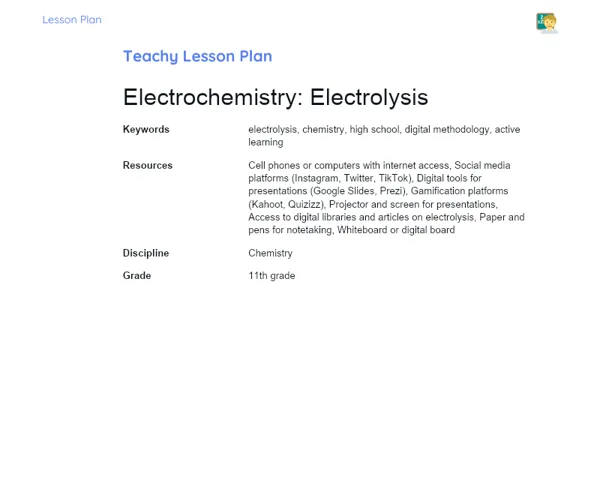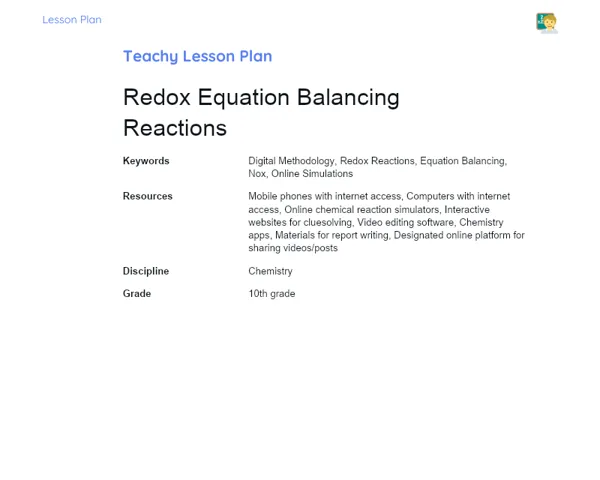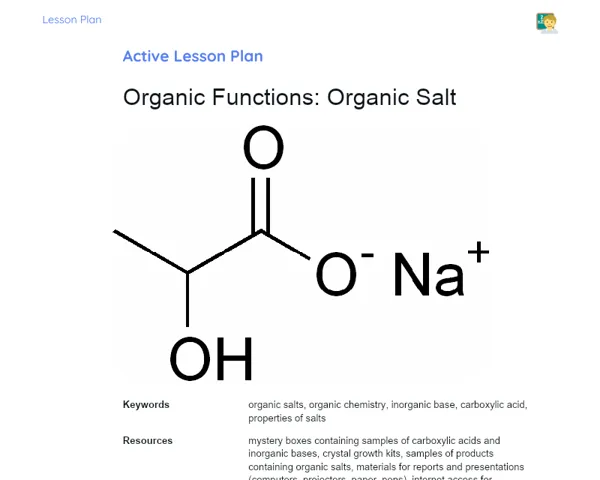Lesson Plan | Lesson Plan Iteratif Teachy | Equilibrium: Partial Pressures
| Keywords | Chemistry, Chemical Equilibrium, Partial Pressures, Equilibrium Constants, Kp, Kc, Digital Methodology, Active Learning, Social Media, Gamification, Vlog, Digital Research, Engagement, Collaboration, Communication |
| Resources | Smartphones or computers with internet access, Social media platforms (Instagram, Twitter, TikTok), Gamification platforms (Kahoot or Socrative), Video editing tools (e.g., iMovie, Adobe Premiere), Video platforms (YouTube), Whiteboard or projector, Supporting materials (tables, graphs, examples of chemical reactions) |
| Codes | - |
| Grade | 11th grade |
| Discipline | Chemistry |
Goal
Duration: (10 - 15 minutes)
This stage aims to introduce learners to the subject matter that will be explored in more depth during the lesson. We want to focus on the key skills that will be developed. These objectives are meant to keep both the teacher and the students focused on what’s truly important, ensuring a clear and effective understanding of the link between Kp and Kc.
Goal Utama:
1. Understand and write the equilibrium constant (Kp) in terms of partial pressures.
2. Relate the equilibrium constant Kp to the equilibrium constant expressed in terms of molar concentrations (Kc).
Goal Sekunder:
- Recognise the significance of partial pressures in the context of chemical reactions at equilibrium.
- Apply the concepts of Kp and Kc to practical problems related to chemical equilibrium.
Introduction
Duration: (10 - 15 minutes)
This phase is designed to prepare students for the content they will engage with during the lesson, emphasising the main skills to be developed. The goals are set to ensure both teacher and students stay on track with what’s important, solidifying their understanding of how Kp and Kc are related.
Warming Up
Kick off the lesson by explaining that chemical equilibrium is a vital concept in many chemical reactions and industrial applications, with partial pressures being a critical way to describe this equilibrium. Encourage students to pull out their smartphones to find an intriguing fact about partial pressures or chemical equilibria in real-world scenarios, such as ammonia production through the Haber-Bosch process or in biological systems.
Initial Thoughts
1. What are partial pressures, and how do they relate to chemical equilibrium?
2. What’s the difference between Kp and Kc?
3. Why is it essential to understand how Kp and Kc relate in real-life chemical processes?
4. How do changes in pressure and concentration impact chemical equilibrium?
5. What examples of real-world applications involving partial pressures did you discover in your research?
Development
Duration: 70-85 minutes
This phase of the lesson plan is designed to offer students an engaging, practical experience that leverages digital technologies and modern contexts to deepen their grasp of partial pressures and equilibrium constants (Kp and Kc). Through the suggested activities, students will gain experience applying their knowledge to real-world situations, while enhancing their research, communication, and collaborative skills.
Activity Suggestions
Activity Recommendations
Activity 1 - 🔎 Chemical Detectives on Social Media
> Duration: 60-70 minutes
- Goal: Involve students in exploring chemical reactions at equilibrium using social media's digital landscape to create fun and educational reports, demonstrating the connection between Kp and Kc.
- Deskripsi Activity: Students will act as 'Chemical Detectives', using social media to dive into various chemical reactions at equilibrium involving partial pressures. They'll create a 'digital report' detailing the examined reaction, the equilibrium constants (Kp and Kc), and how these figures link together. The report can be formatted as an Instagram post, a series of tweets, or a short TikTok video.
- Instructions:
-
Split the class into groups of up to 5 students.
-
Each group selects a chemical reaction at equilibrium to explore.
-
Use social media to uncover pertinent information about the chosen reaction, including industrial production, biological processes, etc.
-
Craft a 'digital report' that includes: a description of the reaction, the involved partial pressures, calculations of the equilibrium constants (Kp and Kc), and their relationship.
-
The report should be presented through an Instagram post, tweet thread, or TikTok video, incorporating all gathered information.
-
Share the report on the selected social media platform and provide the link to the class and the teacher.
Activity 2 - 🎮 Gamification: The Balance Game
> Duration: 60-70 minutes
- Goal: Foster a playful and interactive learning environment through gamification, reviewing and deepening the understanding of partial pressures and equilibrium constants (Kp and Kc).
- Deskripsi Activity: Students will engage in an educational online game that poses various challenges related to the lesson topic. Each challenge will involve solving problems regarding equilibrium constants (Kp and Kc), partial pressures, and their interrelation. The game will be set up on a platform like Kahoot or Socrative.
- Instructions:
-
Divide the class into groups of up to 5 students.
-
Explain how the chosen gamification platform functions (Kahoot or Socrative).
-
Create or select an educational game with questions on partial pressures, the equilibrium constants (Kp and Kc), and their relationship.
-
Launch the game and ask students to respond to questions in their groups.
-
Encourage each group to discuss their answers before submitting.
-
Following the game, review the correct and incorrect responses with the class, addressing any questions and reinforcing concepts.
Activity 3 - 📹 Chemical Influencers: Equilibrium Vlog
> Duration: 60-70 minutes
- Goal: Enhance communication and presentation skills by using the vlog format to clarify chemistry concepts tied to chemical equilibrium and equilibrium constants (Kp and Kc).
- Deskripsi Activity: Students will transform into 'chemical influencers', creating an engaging vlog that explains the concepts of chemical equilibrium, partial pressures, and the equilibrium constants (Kp and Kc). They should use straightforward language and visual aids to make the content both captivating and informative.
- Instructions:
-
Split the class into groups of up to 5 students.
-
Each group selects a specific aspect of the lesson topic to cover in their vlog, such as the definition of partial pressures, detailing equilibrium constants (Kp and Kc), or the connection between Kp and Kc.
-
Research visual aids, tables, graphs, and examples to enrich their presentation.
-
Record a brief video (5-10 minutes) showcasing their chosen topic clearly and attractively.
-
Edit the video to include titles, captions, and visuals.
-
Upload the video on a platform like YouTube or share the link with the class and the teacher.
Feedback
Duration: 15-20 minutes
This segment aims to stimulate reflection on the learning achieved, fostering knowledge and experience exchange among students. Through group discussion and 360° feedback, we aim to reinforce understanding of the concepts studied, pinpoint areas for improvement, and value collaboration and communication, which are key elements for an engaging and effective learning environment.
Group Discussion
Facilitate a group discussion that involves all students, commencing with a brief intro about the significance of sharing what they have learned. Use the following script to steer the conversation: 1. Introduction: Clarify the aim of the discussion and encourage everyone to participate. 2. Presentation of Digital Reports: Ask each group to briefly present their 'digital report', summarising the chemical reaction they investigated, the equilibrium constants (Kp and Kc), and how they relate. 3. Experience and Reflections: Invite students to share any challenges they encountered during their research and the creation of their digital report, along with their most interesting discoveries. 4. Open Discussion: Encourage an open floor for discussions, allowing students to pose questions and comment on their classmates' presentations. 5. Wrap Up: Summarise the key points discussed and remind everyone about the importance of the concepts covered.
Reflections
1. How did the research and creation of the digital report improve your understanding of the relationship between Kp and Kc? 2. What were the main challenges faced during the activity, and how were they resolved? 3. How did the real-life examples you discovered impact your comprehension of theoretical concepts?
Feedback 360º
Incorporate a 360° feedback session where each student receives input from their group members. Emphasise the importance of providing constructive and respectful feedback, showcasing examples of how to achieve this. Guide students to comment on: 1. Positive Aspects: What did each member excel at during the task? 2. Areas for Improvement: What aspects could be enhanced? 3. Collaboration and Communication: How was the engagement and contribution of each member?
Conclusion
Duration: (10 - 15 minutes)
🎯 Purpose of the Conclusion 🎯: The conclusion seeks to reinforce the primary concepts learnt throughout the lesson in a fun and engaging way, tying them back to real-world applications. It also aims to inspire students to appreciate the practical significance of their studies, cementing their learning and underlining the relevance of the concepts acquired.
Summary
🌟 Super Fun Summary 🌟: Today, we journeyed into the fascinating realm of chemical equilibrium! We unraveled the complexities of partial pressures 🔬 and how to express them in the equilibrium constant Kp. More than that, we also delved into how Kp connects with our old pal Kc 📏. It was an exciting scientific adventure, featuring digital detectives and interactive games! 😎
World
🌍 Connecting with Today’s World 🌍: Chemistry is all around us, from food production 🍔 to the pharmaceutical industry 💊. Grasping the concepts of partial pressures and equilibrium constants is vital for industrial processes like ammonia production via the Haber-Bosch process, which is essential for creating fertilizers that nourish our planet! 🌱
Applications
🔬 Applications in Daily Life 🔬: Understanding partial pressures and equilibrium constants sheds light on how to regulate key chemical reactions in our day-to-day lives. For instance, in manufacturing chemical products, medications, and even biological processes happening within our bodies. It's knowledge that drives progress across various fields of science and technology! 🚀



